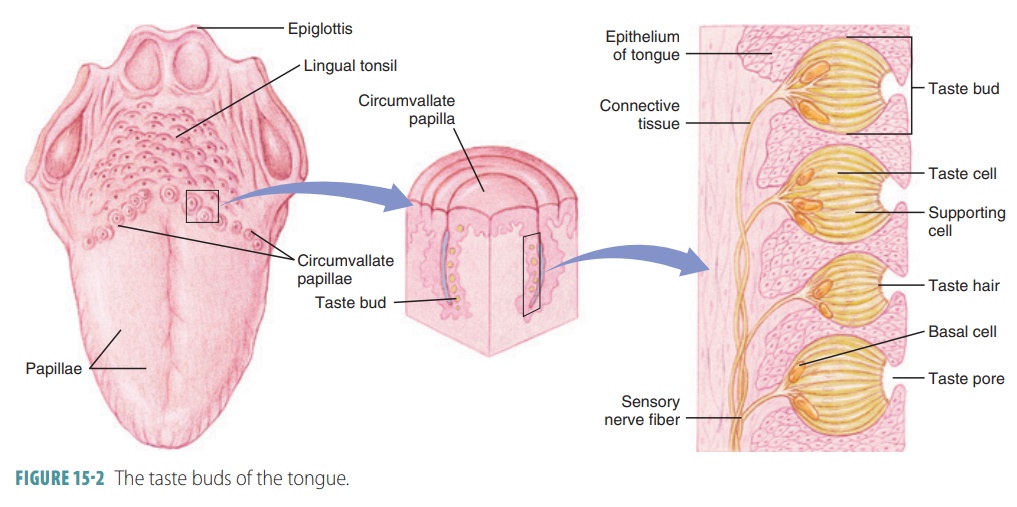Sense of Taste
| Home | | Anatomy and Physiology | | Anatomy and Physiology Health Education (APHE) |Chapter: Anatomy and Physiology for Health Professionals: Special Senses
The special organs of taste, the taste buds, num-ber over 10,000. Most are found on the surface of the tongue, with tiny elevations called papillae.

Sense of
Taste
The special organs of taste, the taste buds, num-ber
over 10,000. Most are found on the surface of the tongue, with tiny elevations
called papillae (FIGURE 15- 2). An adult has approximately 3,000 taste buds. Taste buds are found on
the tops of mushroom-shaped fungiform
papillae, scattered over the surface of
the tongue as well as in the epithe-lium of the large and round circumvallate papillae and the
side walls of the foliate
papillae, which are also called filiform papillae . The circumvallate papillae are the least numerous yet
largest of the various types of papillae. Between 7 and 12 circumvallate
papillae form an inverted V shape on the posterior tongue.
In addition, about 1,000 taste
buds are found on the roof of the mouth, the throat walls, and portions of the
larynx. Each taste bud has up to 150 taste cells (gustatory epithelial cells),
which are replaced every three days. The spherical, flask-shaped taste buds
have openings called taste pores and tiny projections called taste hairs. The taste hairs are the sensitive parts of the taste receptor
cells. Stimulation triggers an impulse on a nearby nerve fiber traveling to the
brain. There are three or more types of gustatory epithelial cells, which may
either form synapses with sensory dendrites and release serotonin or lack
synaptic vesicles and release adenosine triphosphate as a neurotransmitter. The
taste buds also have basal epithelial
cells.

Chemicals must dissolve in
saliva, diffuse into taste pores, and contact gustatory hairs before they can
be tasted. A food chemical is known as a tastant.
When a tastant binds to receptors in a gustatory epithelial cell membrane, a
graded depolarizing potential is induced, causing neurotransmitter release.
Although taste cells in taste buds are similar in appearance, there are following
five types:
■■ Those that sense sweetness
(such as sugar)
■■ Those that sense sourness
(such as lemons)
■■ Those that sense saltiness
(such as table salt)
■■ Those that sense bitterness
(such as caffeine)
■■ Those that sense umami or deliciousness (responding to specific
amino acids and related chemicals such as monosodium glutamate or MSG)
Other sensations that may be
sensed are alkaline and metallic sensations, and it is widely
believed that humans can take long-chain fatty acids from lipids. This may
explain why foods containing fats are so popular. Additionally, there is water receptors located mostly in the
pharynx. Their sensory output is processed in the hypothalamus and affects
water balance, regulation of blood volume, and antidiuretic hormone secretion.
Flavors are tasted because of
combinations of the primary sensations. The sense of smell also influences the
flavors that are tasted. Though it was tradition-ally believed that specific
areas of the tongue only responded to one type of “taste,” further research has
revealed that all of the tongue is
able to taste the sensa-tions of sweetness, sourness, saltiness, bitterness,
and umami (deliciousness).
Taste sensations like smell
sensations also adapt rapidly. Sensory impulses from the tongue travel to the
medulla oblongata via the facial, glossopharyn-geal, and vagus nerves. Then,
they move to the thal-amus (located in the diencephalon) and gustatory cortex
(located in the parietal lobe of the cerebrum). Mostly, however, afferent
fibers that carry taste infor-mation from the tongue are found in two cranial
nerve pairs. The chorda tympani,
branching off the facial nerve (VII), carry impulses from the
anterior two-thirds of the tongue. The posterior third of the tongue and the
pharynx located just behind are serviced by the lingual branch of the glossopharyngeal nerve (IX). The vagus nerve (X) is responsible for
carrying taste impulses from the epiglottis and lower pharynx. The afferent
taste fibers synapse in the solitary
nucleus of the medulla. Impulses then move to the thalamus and end up in
the gustatory cortex of the insula.
Humans can appreciate tastes because of fibers that project to the hypothalamus
and structures of the limbic system.
The sense of taste is actually
mostly based on smell, to about 80%. Food lacks taste when the nasal passages
are congested. Without smell, the sense of taste would be very inefficient, and
much of what we enjoy from var-ious flavors could no longer be appreciated.
The sense of taste is intensified by food temperatures and textures.
Thermoreceptors, mechanoreceptors, and nociceptors in the mouth are involved
here. An example is a spicy pepper that becomes more pleasurable because, in
addi-tion to its taste, it excites pain receptors in the mouth.
Taste sensitivity among
individual people differs widely. A variety of inherited conditions influences
your taste sensitivity, such as the compound known as phenylthiourea or phenylthiocarbamide. Approxi-mately, 70% of
people throughout the world perceive this substance as bitter, whereas others
cannot taste it at all. It does not occur in food, but related chemicals do,
mostly in certain Asian or Australian fruits.
1. Name
the five primary taste sensations.
2. Describe
which types of receptors are used in the senses of smell and taste.
3. Explain
the foliate and fungiform papillae of the taste buds.





